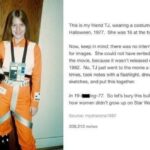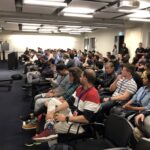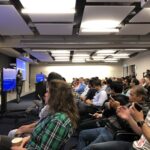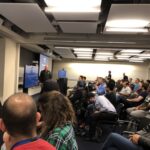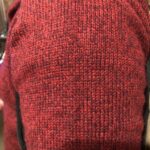
Month: October 2019
-
Shared today on Twitter
RT @HannahRKeyser: I don’t think I’m overstating the issue when I say that the most maddeningly unreasonable aspect of modern life is that…
RT @ITF_Australia: We had a great day on Tuesday in Liverpool (Southwest Sydney) hosting an Inspiring Women event involving over 200 female…
RT @jessbudd4: I wrote a thing about my experience getting into public speaking 🙂
It’s only part one because I haven’t actually done the s…
@annie_parker Many happy returns of the day! 👏❤️🎉
-
Shared today on Twitter
RT @alicegoldfuss: “HTML isn’t a programming language!”
HTML was my first experience telling a computer what to do with code. It got me in…
RT @mpesce: My latest for @TheRegister is an unhappy story of how a billionaire boys club effectively *blocked* female participation in sci…
Just about every single day. https://t.co/nImmApJz7d
I really hope this still isn’t the situation, @asmallorange. I don’t want to move my sites again. 🙁 https://t.co/B3VQdq6Pgw
@40greenshades Nah, just basic stuff for now, thank you.
-
Shared today on Twitter
Leadership lesson: “Irreplaceable is unpromotable.” If you make it yourself irreplaceable, congrats. That’s now your job for life.
@twelveeyes Yes! Somebody tagged me on it on Facebook but I hadn’t seen the actual collection yet. Thank you! 😍
RT @crochetverse: It happened! XENOMORPH ALIEN! Fully freehand #crochet, no pattern! He glows in the dark too!! #Alien #xenomorph #alienvsp…
Honestly, one of the best days I’ve had since I took this job. (I met a SPACE LAWYER. And a lady trying to set up Australian Space Camp. And a guy who is on a first name basis with Buzz Aldrin.) 👩🚀🌏❤️
RT @MattLune: Amazing 🙌 https://t.co/FPXS6TcjE9
They’re gonna sell off @meetup as I feared, you watch. 😕 https://t.co/XmsKaZV5Mm
@mushuweasel Hello! I’m not looking for lace at the moment. The linked blog post has what I’m after as well as the email address. (I have an automated system set up to process the attachments.)
@KiahHickson @crochetverse Retweeted it yesterday! 😉 I don’t like much crochet, but I do like this.
-
Shared today on Twitter
@malamentary @kingdomofwench No, just the four basic stitches in the blog post for now! But thank you.
@LiviuC_PhD Nah, very few of us actually go over for it! No plans for me. 🙂
@randolph5of5 Haha, I’m not a big fan of lace so I’m encoding that bias in my algorithm. 😂
Nice full crowd for tonight’s Sydney Data Engineering Meetup at AWS! @petehanssens always puts on a good event. 👏 https://t.co/FDMESA7vB0
I kind of want to knit a jumper with every single one of these. Right after I do the one with the original DoCoMo emoji… https://t.co/2iOoZfDcx2
Next up is Najah talking about Open District for Elasticsearch… https://t.co/IP0xA5JCAI
Final speaker is Chris Horder telling us about stream processing in 2019… https://t.co/gxFOWtaX8Q
When to use SQS vs Kinesis vs MSK vs Kafka on EC2. This is helpful! https://t.co/VtMQNJBK5L
@DieEineLms @gruenzeug Thank you!! ❤️
RT @Amys_Kapers: #Frocktober day 4 and when you have a chance to get your face on a dress you have to take it!
Shout out to @kristysachse a…
@Amys_Kapers @kristysachse @GrombleTromble WHY DON’T I HAVE A DRESS WITH MY FACE ON IT 🤔
-
Shared today on Twitter
RT @acnewsitics: BREAKING: Mexico said they’d be happy to pay for Trump’s impeachment.
@developerjack @IngaPflaumer @truckerfling @johnallsopp I’m happy to help if somebody else organises!
Me in the elevator: “This is weird, but can I take a photo of your jumper?”
Random guy: “Sure, uh, okay.”This is my life now. #knittingml https://t.co/u9S8HgDCRd
@knitcodemonkey Are you also accumulating swatches for a data set to train a neural network to reverse engineer knitting patterns? 😂
@knitcodemonkey Well please email some of those to me if you haven’t already! That one there is a good one for stocking stitch. 🙂 https://t.co/uW5ZY9cz3W
RT @sarahhbickerton: Ok, yes, there is something wrong with Twitter.
No, it’s not what it usually wrong with Twitter.
@1n9r1d @sianrobyns @tippy_top I only want stitch patterns, not full garments. Not sure if I could get high enough res…
@DuchessFounder Machine knitting is fine! I’m just after basic stitches though, so as long as it’s stockinette/garter/moss/seed then please send it through. 😁
@SWbioinf Thank you!
@jesslynnrose I loved Charles Petzold’s book Code: The Hidden Language of Computer Hardware and Software. https://t.co/s6zm7YPhxc
@tippy_top @1n9r1d @sianrobyns No rib, thanks! Original tweet has what I’m after: stockinette, garter, moss, and seed. There’s an email address to send them.
@IngaPflaumer Sweet! I’m only after basic stitches – nothing too fancy yet. https://t.co/f7hWHINBf2
Current progress: 260 images. Thanks everyone! My goal is at least 1000, so please keep ’em coming. #knittingml https://t.co/uW5ZY9u9Vu
@Amys_Kapers @evanderkoogh Yes. This.
RT @AndrewGillum: RT for impeachment & removal.
❤️ for resignation.I’m doing both.
+ @realDonaldTrump so he sees it.
How odd. We just had a Medicare claim paid three years later. 🤷♀️
RT @dev_nq: We’re thrilled to announce @web_goddess from @awscloud will be speaking at our next meetup! Join us on October 30th at @SafetyC…
@developerjack We tracked it down from the cryptic number on the bank statement, which turned out to be a date. They never paid the rebate back then, so it’s legit. Just no idea why it suddenly happened 3 years later…
-
Shared today on Twitter
I’m taking the year off #frocktober, but I’m still supporting! Please consider donating to @ocrfaustralia through my friend @Amys_Kapers 👗 https://t.co/piCc7UBz48
RT @Amys_Kapers: Well it’s that time of year again, it’s #Frocktober day 1
For those just tuning in, for the next month I’ll be wearing on…
@truckerfling @johnallsopp I ran it for Sydney in 2018, and @IngaPflaumer ran it in 2019. There were organisers in several other AU cities as well.
@mootpointer If you don’t make mistakes, you never learn how to fix them! Bring your knitting to the next STL and I’ll show you how to pick them up. 🙂
@Amys_Kapers @mootpointer Just zoom in on a bit that doesn’t show them!
RT @womensart1: Orly Genger, contemporary US, NY based sculptor known for her large scale crocheted and knitted outdoor installations #wome…
@jamescmcpherson @SoniaCuff Brilliant – thank you!
Wondering if I can get a signal boost from @JanelleCShane? 😉 I’m gonna need a lot more images! https://t.co/uW5ZY9u9Vu
I’m only 70 images, so really hoping that some of these folks retweeting will actually contribute!
@mikeforbes @ravelry Yep. Already posted in both Loose Ends (on the Big Six) and Australian Knitters. 🙂
@DuchessFounder @JanelleCShane Yep. Already posted in both Loose Ends (on the Big Six) and Australian Knitters. 🙂
@sauramaia …I don’t get it? Goal is to train a neural network to reverse engineer knitting patterns from a photo of finished work.
@minxdragon Thank you!
@minxdragon @sauramaia Yeah… most photos are going to be whole garment, so I don’t think resolution will be high enough. And I was hoping that by enlisting knitters I could get images that would require less cleanup after. (I’m still going to need help from folks to label.)
@minxdragon @sauramaia You’re way more experienced with this than me! I’m trying to make this MVP as simple and likely to succeed as possible. 🙂
@sauramaia @minxdragon First two are good, I think. The one where shawl is rumpled… not sure. I’ll say no on the wristwarmer – having it on the body makes it difficult and it looks ribbed?
@KrysaliaH I am a very long time Rav member and already shared there about 8 hours ago. Not seeing a lot of response yet.
@randomknits Garter/stockinette/moss/seed for now please!
Since a few folks have asked – yes, it’s already been posted on @ravelry. 😉 https://t.co/bccyZNsgYG
@minxdragon I actually hooked the email address up to a lambda that saves the image straight into S3, so I was hoping that people emailing me images would also save me the trouble having to save them and reupload myself!
@KrysaliaH No crochet right now, thanks. The blog post (https://t.co/f7hWHINBf2) has exactly what I’m after.
Yep, also exploring scanning/scraping from stitch guides too. Email processing pipeline was just the first approach!
@sauramaia @minxdragon Would you be able to email them? I spent all Sunday setting up pipeline from email straight through to S3 so I don’t have to download/reupload hundreds of photos!
@yoyohanna No lace!! If you click the link in the tweet, it goes to blog post with what I”m after. Literally just starting with stocking stitch, garter, seed, and moss.
@sauramaia @minxdragon Phew, thank you. My greatest fear is a viral thread of people sending me photos and I have to scrape them all. 😂 (PS one of those looks ribbed. I’m skipping ribbing for now. Just garter, stocking, moss, and seed)
@minxdragon Only if it’s included in the filename. I’m planning to set up Amazon Ground Truth and recruiting some volunteers to help me label.
@minxdragon Sagemaker Ground Truth, that is
@yoyohanna Thank you!
@randomknits 🙌
@randomknits PS expect to get unlisted as a labelling volunteer too. 😛
@randomknits Was meant to say “enlisted,” of course. Don’t you want to get on the good side of our future AI Knitting Computer Robot overlords?
@ceibner That works! Can you please drop in an email to knittingml@krishoward.org? I have a processing pipeline set up 😉
@ceibner Thank you my dear!!
Currently up to 113 images! Not bad for the first day…
RT @randomknits: Got knitting? @krishoward is collecting images of stockinette, garter, moss and seed stitch for a machine learning project…
@DataRenee Really excellent point!
@RobMurrish I thought about it, and synthetic data has been used to augment training data for other attempts. I’m keeping it in my back pocket as a fallback if I don’t get enough real samples.
@stringy Wooooo! Please. 🙂
PLEASE click and read the blog post about the types of images I’m after before sending! Whole garment photos aren’t really useful at this point, and I’m only after basic stitches.
@JanelleCShane Thanks! A friend pointed me to that paper a while back. I’m sure there are other people working on the same thing. I’m not a researcher; this is just a funny little passion project to learn about ML so I’m starting small to see what I can learn!
@doridoidea That’s absolutely amazing – thank you for sharing! I will definitely see if I can augment with your photos and cite your work if I do.
@JacobsThorin @GalaxyKate That’s correct – just those to start with.
@mackles01 I got some advice from an expert last week who suggested I leave them in colour for now. He also gave advice on how I could twiddle the colours to potentially create more training data. So “as is” to start!
@karinslegers @katta_spiel Thank you!
Woke up to a lot of replies and notifications that I’d received a lot more emailed photos! Currently up to about 200. Most helpfully, @JanelleCShane and @doridoidea pointed me to some existing data sets I can use to augment the one I’m building! 😍
@betsybookworm Having a BIG Twitter name is such a good idea! I wish more of them did it. 🙂
@phoebegoh At this point, the tech talk I’ll give about this project is going to be 80% cleaning up the data. 😂 I mean, I kinda knew based on what I’d read of other ML projects, but this really brings it home…
RT @JimMFelton: VidEo GaMes DoNT LeAd To VioLenCe https://t.co/eAVBei0aGa
@frostickle @darkhorse166 I don’t know who you-know-who is, but the callout is also on Ravelry if they’re there. 🙂 https://t.co/bccyZNsgYG
@amberhimesmatz @DuchessFounder @JanelleCShane I thought about it, but most photos there are of completed articles. Rarely do folks bother to take high-res images of particular stitch patterns, unless they’re tricky or weird (which I’m excluding from this MVP). I also figure people contributing sidesteps permission issue.
RT @mipsytipsy: Btw, if you have any interest whatsoever in observability-driven development, engineering culture, or how functional teams…
@mipsytipsy My favourite part is all the spot puns. 😜
-
Knitted Disruption
Hey knitters! I’m working on a knitting + machine learning project and I need a collection of images of stockinette, garter, seed, and moss stitches. Images like these:
If you’re willing to spend a few minutes helping, I’d be so grateful! Just email your images to knittingml@krishoward.org. You can attach multiple images at once if you like.
They don’t have to be swatches; they can be closeups from finished articles. They don’t have to be perfectly straight or blocked or anything like that either. I’m looking for a wide variety, to be honest! Stripes and multiple colours are great! Even fairisle. I want to teach the model to disregard colour, so having photos with it is very helpful. Just no lace or cables or crochet… (yet).
More details
A few years back I gave a talk at several tech conferences about the overlap between knitting patterns and programming languages. As part of that, I talked a bit about KnitML (an old proposed standard for writing patterns in ways computers can understand) and how it could be used with special software to simulate knitted fabric. A few people asked me afterwards if it could go the other way – from a photo of knitting, can you reverse engineer the pattern?
It got me thinking. I know that I can “read” knitting. I do it all the time, and I’m sure other knitters do too. So if I can do it, why not a computer? I’m also fortunate in that I work with some very smart Machine Learning experts and have access to run experiments in the Cloud cheaply. So I decided to give it a try.
I’m starting with image classification. Think facial recognition for knitting swatches. Can I train a model to recognise the difference between stockinette, garter, moss, and seed stitch? The first step is gathering as much training data as I can, hence my request to you all!
So the more the better. Different wools, different colours, different lighting, different angles. It’s all super useful!
And I will definitely share the results back afterwards and thank all contributors. 🙂

